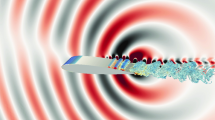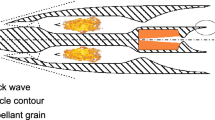Abstract
The effect of an initial disturbance on the detonation front structure in a narrow duct is studied by three-dimensional numerical simulation. The numerical method used includes a high-resolution fifth-order weighted essentially non-oscillatory scheme for spatial discretization, coupled with a third-order total variation diminishing Runge-Kutta time-stepping method. Two types of disturbances are used for the initial perturbation. One is a random disturbance which is imposed on the whole area of the detonation front, and the other is a symmetrical disturbance imposed within a band along the diagonal direction on the front. The results show that the two types of disturbances lead to different processes. For the random disturbance, the detonation front evolves into a stable spinning detonation. For the symmetrical diagonal disturbance, the detonation front displays a diagonal pattern at an early stage, but this pattern is unstable. It breaks down after a short while and it finally evolves into a spinning detonation. The spinning detonation structure ultimately formed due to the two types of disturbances is the same. This means that spinning detonation is the most stable mode for the simulated narrow duct. Therefore, in a narrow duct, triggering a spinning detonation can be an effective way to produce a stable detonation as well as to speed up the deflagration to detonation transition process.
Similar content being viewed by others
References
Kailasanath K.: Review of propulsion applications of detonation waves. AIAA J. 38, 1698–1708 (2000)
Roy G.D., Frolov S.M., Borisov A.A., Netzer D.W.: Pulse detonation propulsion: challenges, current status, and future perspective. Prog. Energy Combust. Sci. 30, 545–672 (2004)
Lee, J.H.S.: The propagation mechanism of cellular detonation. In: Jiang, Z. (ed.) Shock Waves: Proceedings of the 24th International Symposium on Shock Waves, vol. 1, pp. 19–30. Springer, Berlin
Mitrofanov V.V.: Modern View of Gaseous Detonation Mechanism, Progress in Astronautics and Aeronautics, vol. 137. Washington DC, AIAA (1996)
Lu, F., Bellini, R.: Progress in modeling pulse detonations. Lecture Notes in Workshop on Moving Interface Problems and Applications in Fluid Dynamics, 8 Jan–31 Mar, IMS, NUS (2007)
Taki S., Fujiwara T.: Numerical analysis of two dimensional nonsteady detonations. AIAA J. 16, 73–77 (1978)
Oran E., Young T., Boris J.: Application of time-dependent numerical methods to the description of reactive shocks. Proc. Combust. Inst. 17, 43–54 (1978)
Kailasanath K., Oran E.S., Boris J.P., Young T.R.: Determination of detonation cell size and the role of transverse waves in two-dimensional detonations. Combust. Flame 61, 199–209 (1985)
Bourlioux A., Majda A.J.: Theoretical and numerical structure of unstable detonations. Philos. Trans. Roy. Soc. London Ser. A 350, 29–68 (1995)
Gamezo V.N., Desbordes D., Oran E.S.: Formation and evolution of two-dimensional cellular detonations. Combust. Flame 116, 154–165 (1999)
Sharpe G.J.: Transverse waves in numerical simulations of cellular detonations. J. Fluid Mech. 447, 31–51 (2001)
Oran E.S., Weber J.E., Stefaniw E.I., Lefebvre M.H., Anderson J.D.: A numerical study of two-dimensional H2–O2–Ar detonation using a detailed chemical reaction model. Combust. Flame 113, 147–163 (1998)
Hu X.Y., Khoo B.C., Zhang D.L., Jiang Z.L.: The cellular structure of a two-dimensional H-2/O-2/Ar detonation wave. Combust. Theory Model. 8, 339–359 (2004)
Fan H.Y., Lu F.K.: Comparison of detonation processes in a variable cross-section chamber and a simple tube. J. Propul. Power 21(1), 65–75 (2005)
Fan H.Y., Lu F.K.: Numerical simulation of detonation processes in a variable cross-section chamber. Proc. Inst. Mech. Eng. Part G J. Aerosp. Eng. 222(5), 673–686 (2008)
Qu Q., Khoo B.C., Dou H.-S., Tsai H.M.: The evolution of a detonation wave in a variable cross-sectional chamber. Shock Waves 18, 213–233 (2008)
Williams D.N., Bauwens L., Oran E.S.: Detailed structure and propagation of three-dimensional detonations. Proc. Combust. Inst. 26, 2991–2998 (1997)
Tsuboi N., Katoh S., Hayashi A.K.: Three-dimensional numerical simulation for hydrogen/air detonation: rectangular and diagonal structures. Proc. Combust. Inst. 29, 2783–2788 (2002)
Deiterding R., Bader G.: High-resolution simulation of detonations with detailed chemistry. In: Warnecke, G. (eds) Analysis and Numerics for Conservation Laws, pp. 69–91. Springer, Berlin (2005)
He, H., Yu, S.T.J., Zhang, Z.-C.: Direct Calculations of One-, Two-, and Three-dimensional detonations by the CESE method, AIAA Paper 2005-0229 (2005)
Eto K., Tsuboi N., Hayashi A.K.: Numerical study on three-dimensional C-J detonation waves: detailed propagating mechanism and existence of OH radical. Proc. Combust. Inst. 30, 1907–1913 (2005)
Deledicque V., Papalexandris M.V.: Computational study of three-dimensional gaseous detonation structures. Combust. Flame 144, 821–837 (2006)
Dou H.-S., Tsai H.M., Khoo B.C., Qiu J.: Simulations of detonation wave propagation in rectangular ducts using a three-dimensional WENO scheme. Combust. Flame 154, 644–659 (2008)
Hanana M., Lefebvre M.H., Van Tiggelen P.J.: Pressure profiles in detonation cells with rectangular and diagonal structures. Shock Waves 11, 77–88 (2001)
Tsuboi N., Hayashi A.K.: Numerical study on spinning detonations. Proc. Combust. Inst. 31, 2389–2396 (2007)
Schott G.L.: Observations of the structure of spinning detonation waves. Phys. Fluids 8, 850–865 (1965)
Zhang F., Gronig H.: Spin detonation in reactive particles-oxidizing gas flow. Phys. Fluids A 3(8), 1983–1990 (1991)
Ishii K., Gronig H.: Behavior of detonation waves at low pressures. Shock Waves 8, 55–61 (1998)
Zhang F., Murray S.B., Gerrard K.B.: Aluminium particles-air detonation at elevated pressures. Shock Waves 15, 313–324 (2006)
Huang Z.W., Lefebvre M.H., Van Tiggelen P.J.: Experiments on spinning detonations with detailed analysis of the shock structure. Shock Waves 10, 119–125 (2000)
Mizutani T., Matsui H., Sanui H., Yonekura M.: Decompsoing detonation and deflagration properties of ozone/oxygen mixtures. J. Loss Prev. Process Ind. 14, 559–565 (2001)
Achasov O.V., Penyazkov O.G.: Dynamics study of detonation-wave cellular structure 1.Statistical properties of detonation wave front. Shock Waves 11, 297–308 (2002)
Kasimov A.R., Stewart D.S.: Spinning instability of gaseous detonations. J. Fluid Mech. 466, 179–203 (2002)
Ivleva T.P., Merzhanov A.G.: Structure and variability of spinning reaction waves in three-dimensional excitable media. Phys. Rev. E 64, 036218 (2001)
Tsuboi N., Asahara M., Eto K., Hayashi A.K.: Numerical simulation of spinning detonation in square tube. Shock Waves 18, 329–344 (2008)
Dou, H.S., Tsai, H.M., Khoo, B.C., Qiu, J.: Three-dimensional simulation of detonation waves using WENO schemes, In: 45th AIAA Aerospace Sciences Meeting and Exhibit, Reno, Nevada, 8–11 Jan 2007 (AIAA Paper-2006-1177)
Vasil’ev A.A.: Cell size as the main geometric parameter of a multifront detonation wave. J. Propul. Power 22, 1245–1260 (2006)
Jiang G.S., Shu C.W.: Efficient implementation of weighted ENO schemes. J. Comput. Phys. 126, 202–228 (1996)
Toro E.F.: Riemann solvers and numerical methods for fluids dynamics. Springer, Berlin (1997)
He X., Karagozian A.R.: Numerical simulation of pulse detonation engine phenomena. J. Sci. Comput. 19(1–3), 201–224 (2003)
Author information
Authors and Affiliations
Corresponding author
Additional information
Communicated by L. Bauwens.
Rights and permissions
About this article
Cite this article
Dou, HS., Khoo, B.C. Effect of initial disturbance on the detonation front structure of a narrow duct. Shock Waves 20, 163–173 (2010). https://doi.org/10.1007/s00193-009-0240-8
Received:
Revised:
Accepted:
Published:
Issue Date:
DOI: https://doi.org/10.1007/s00193-009-0240-8




